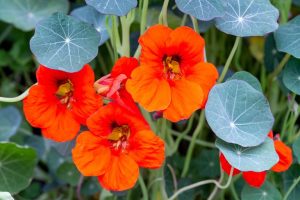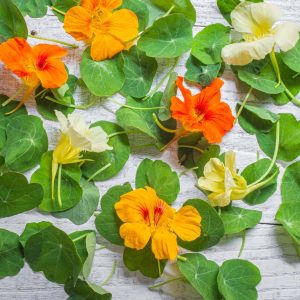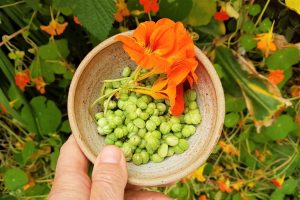
BENEFITS OF NASTURTIUM
Benefits of nasturtium. This herbaceous plant, has been utilized in traditional medicine practices in regions like South America since at least the 1500s. These plants were traditionally used to make teas and tonics for soothing sore throats and colds, as well as using the flowers, seeds, and leaves as natural antibiotics to aid in healing internal infections.
BENEFITS OF NASTURTIUM
Recent studies have shown that nasturtium plants possess many healing properties, thanks to their antioxidants, vitamins, trace elements, and bioactive compounds that can aid the immune, kidney, bladder, respiratory, and digestive systems.
1. Excellent provider of vitamin C

Nasturtium leaves and flowers are packed with antioxidants and various nutrients, such as vitamin C. Some studies indicate that the flowers have approximately 130 milligrams of vitamin C in a 3.5-ounce serving, which is comparable to the amount found in nutrient-rich parsley. Moreover, plants from the Tropaeolaceae family provide essential nutrients such as potassium, phosphorus, magnesium, calcium, manganese, copper, zinc, and iron.
2. Rich in Antioxidants, Lutein Included
These plants excel in providing an abundant supply of lutein, an antioxidant linked to safeguarding against free radical damage and promoting the health of skin and eyes. Nasturtium can provide up to 45 milligrams of lutein per 100-gram serving, making it one of the highest sources found in any edible plant or herb. opper, zink en ijzer.
3. Natural Antibacterial and Anti-Inflammatory Properties

However, research has shown that the essential oil (derived from the flowers and leaves) and compounds extracted from different parts of these plants exhibit natural antimicrobial, antifungal, hypotensive, expectorant, anti-inflammatory, and anticancer properties. Research indicates that the leaves have natural antibiotic properties that could assist individuals dealing with various illnesses and infections, including respiratory infections, congestion, coughs, bronchitis, and colds. In conventional herbal medicine, some species are utilized for the treatment of urinary tract infections.
More benefits
The leaves, flowers, and seeds of nasturtium are edible and provide a peppery taste to salads, sandwiches, and various other dishes. They are abundant in vitamin C and other antioxidants, which bolster immune health and combat inflammation.
4. Nasturtiums can be eaten
Meanwhile, they not only look appealing and taste delicious, but you can also consume the WHOLE plant! The leaves have a mildly warm peppery taste akin to that of watercress and rocket. The blossoms are softer and have sweet nectar. The seeds are also edible, despite being hot and fragrant. However, a word of caution: never consume any flower or plant that has been treated with pesticides or other chemicals! Use organic seeds to begin with.
5. packed with nutrients

Also, the leaves boast high levels of vitamin C (which aids in maintaining a robust immune system), iron, and various other minerals. Meanwhile, the flowers are rich in vitamins B1, B2, B3, and C, as well as manganese, iron, phosphorus, and calcium.
Summary
Nasturtiums produce a mustard oil that attracts insects, causing them to pursue it over any nearby cabbage, cauliflower, broccoli, Brussels sprouts, kohlrabi, and turnips. While it is delightful to have them meandering among the crops as a decoy for insects and a flavor-enhancer, I have discovered that slugs like to conceal themselves under the shade of their wide leaves.